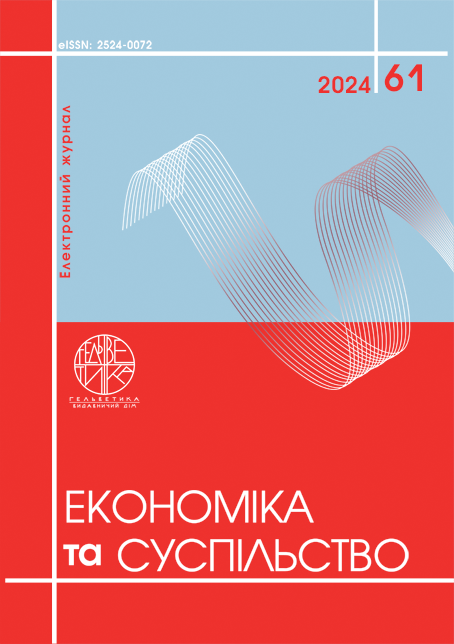ACTUALIZATION OF THE APPLICATION OF LABOR REGULATION IN THE ORGANIZATION OF LABOR AND WAGES
Abstract
The article is devoted to topical issues of the application of labor norms and standards in the context of optimization of the production process. In particular, the work is devoted to the analysis and determination of the role of labor regulation in the organization of labor and the formation of wages, the study of the types of labor regulations and their features, as well as the determination of the impact of various factors on the size of working time costs. The article also discusses the main tasks of labor regulation, which include the development of working time standards, the determination of production standards, the establishment of work volumes, as well as the determination of optimal working conditions. This process is important for ensuring the rational use of labor resources and achieving high quality products or services. The impact of labor regulation on the quality of the working environment, contributing to the safety and comfort of workers, is unclear. It was determined that labor regulation includes not only the establishment of quantitative indicators, but also the consideration of qualitative aspects of labor activity. It is important to take into account the physiological and psychological characteristics of employees, as well as to ensure their safety and well-being at the workplace. Labor rationing plays a decisive role in modern organizations, affecting the organization of the production process. This process is an integral part of effective management of labor resources and achievement of optimal results in production activities. Thanks to labor rationing, it is possible to systematize the labor process and establish standards that determine working hours, production volume, and other key parameters. This helps clarify expected results and provides a basis for rational use of working time and resources. The application of innovations in the technological field can also affect the expansion or reworking of the work duties of employees. The labor regulation system becomes a tool that helps to define new requirements and expectations in this context, contributing to the adaptation of employees to changes. The interaction of organizational and technical changes with the labor regulation system determines the competitiveness and flexibility of the organization in conditions of constant change.
References
Арапов О.С., Дорошенко Т.М. Нормування праці як фактор підвищення ефективності виробництва. Економічний аналіз. 2017. Т. 27, № 4. С. 188–195.
Бутенко Д.С. Теорія управління персоналом на засадах нормування праці та дослідженні витрат робочого часу. Молодий вчений. 2019. № 1(2). С. 433–437. URL: http://nbuv.gov.ua/UJRN/molv_2019_1(2)__44
Водянка Л.Д., Зрибнєва І.П., Сибирка Л.А. Особливості нормування праці в сучасних кризових умовах господарювання. Вісник Чернівецького торго-вельно-економічного інституту. Економічні науки. 2017. Вип. 1-2. С. 98–105.
Ковальова О.М. Роль нормування праці в системі управління трудовим потенціалом. Економічний простір. 2020. № 153. С. 61–64.
Седляр М.О. Проблеми нормування праці в умовах становлення постіндустріального суспільства. Східна Європа: економіка, бізнес та управління. 2020. Вип. 2. С. 281–286. URL: http://nbuv.gov.ua/UJRN/cxeebu_2020_2_43
Arapov O.S., Doroshenko T.M. (2017) Normuvannya pratsi yak faktor pidvyshchennya efektyvnosti vyrobnytstva [Labor rationing as a factor in improving production efficiency]. Ekonomichnyy analiz. vol. 27, no. 4. pp. 188–195.
Butenko D.S. (2019) Teoriya upravlinnya personalom na zasadakh normuvannya pratsi ta doslidzhenni vytrat robochoho chasu [Theory of personnel management on the basis of labor rationing and research of labor costs]. Molodyy vchenyy. vol. 1(2). pp. 433–437. Available at: http://nbuv.gov.ua/UJRN/molv_2019_1(2)__44
Vodyanka L.D., Zrybnyeva I.P., Sybyrka L.A. (2017) Osoblyvosti normuvannya pratsi v suchasnykh kryzovykh umovakh hospodaryuvannya [Peculiarities of labor rationing in modern crisis management conditions]. Visnyk Chernivetsʹkoho torhovelʹno-ekonomichnoho instytutu. Ekonomichni nauky. vol. 1–2. pp. 98–105.
Kovalʹova O.M. (2020) Rolʹ normuvannya pratsi v systemi upravlinnya trudovym potentsialom [The role of labor rationing in the system of labor potential management]. Ekonomichnyy prostir. vol 153. pp. 61–64.
Sedlyar M.O. (2020) Problemy normuvannya pratsi v umovakh stanovlennya postindustrialʹnoho suspilʹstva [Problems of labor rationing in the conditions of formation of post-industrial society]. Skhidna Yevropa: ekonomika, biznes ta upravlinnya. vol. 2. pp. 281–286. Available at: http://nbuv.gov.ua/UJRN/cxeebu_2020_2_43

This work is licensed under a Creative Commons Attribution 4.0 International License.


